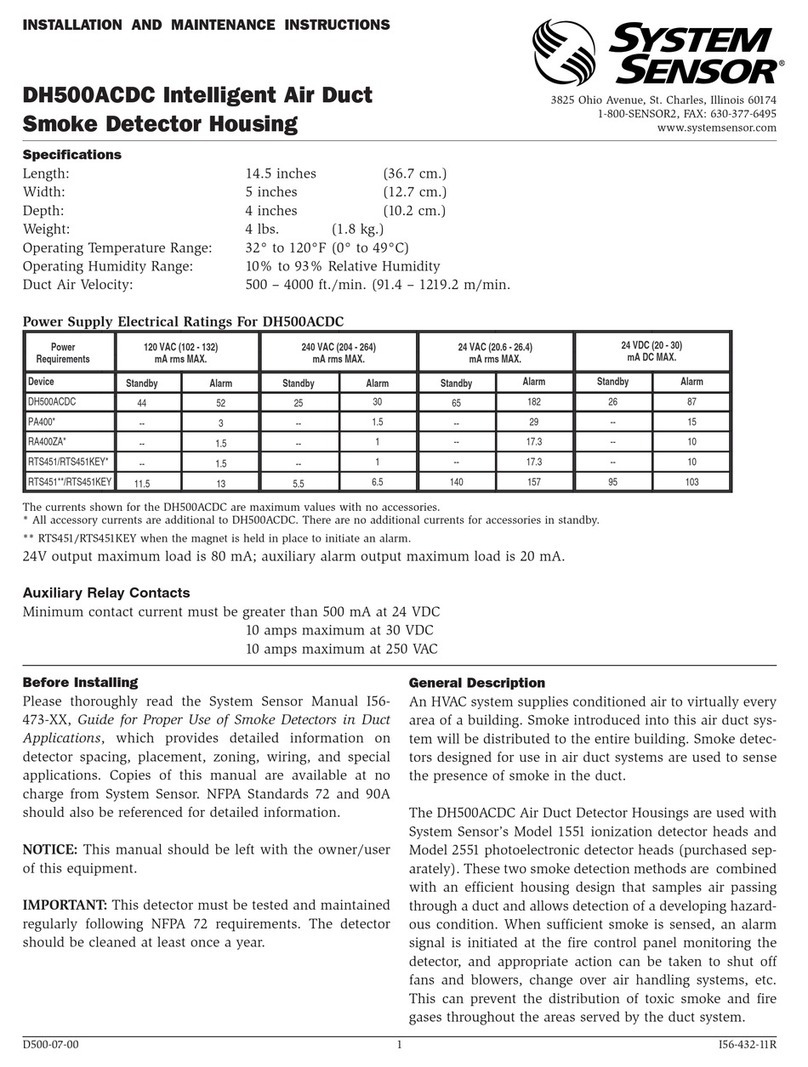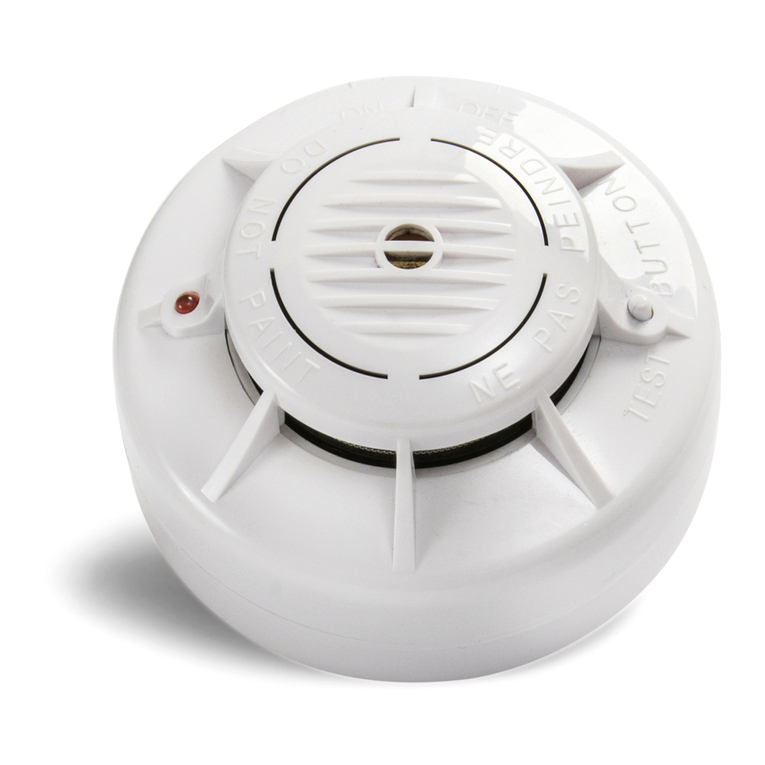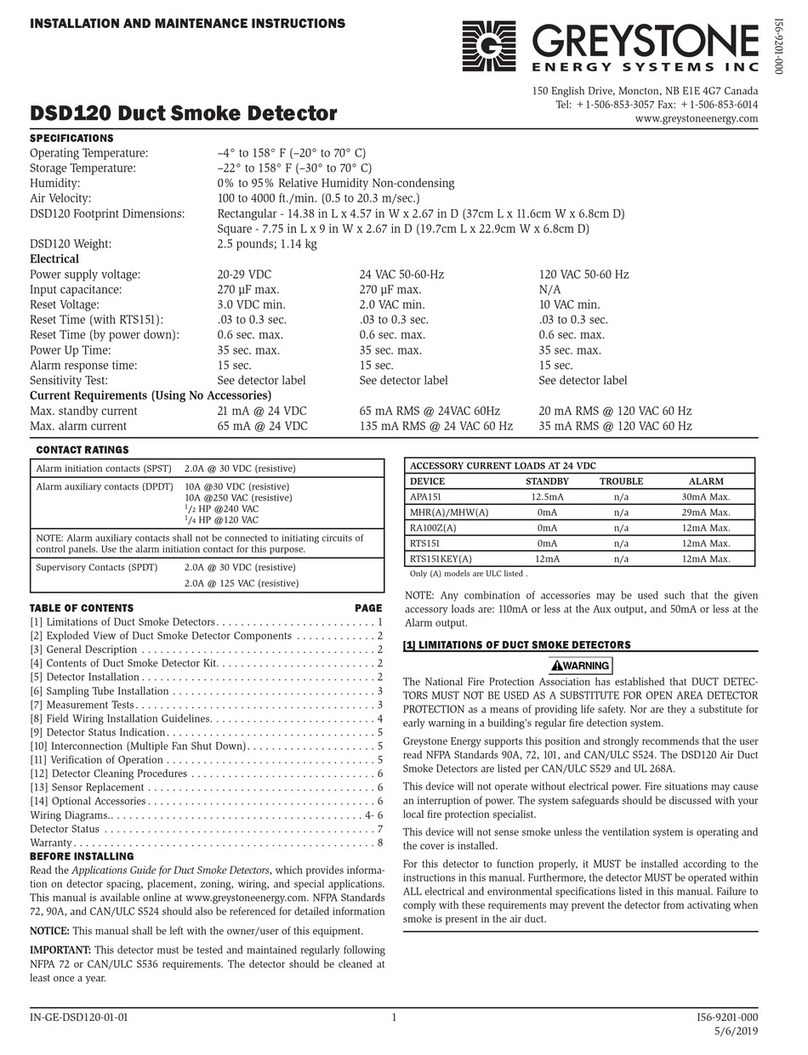6Dräger Polytron Pulsar 2
Understanding the system
4Low-supply Mode. Flashes of increased intensity are
output at a regular 2Hz rate. This is substituted for
Alignment Mode if the Transmitter detects that the supply
voltage dips below the specified range when tested with
the lens heater on. This test is only carried out during
alignment (and hence at the time of commissioning the
detector) so that it cannot delay a gas alarm if this
coincides with a deteriorating supply.
5Fault Mode. Flashes of maximum intensity are output at a
regular 1Hz rate. This is substituted for Normal Mode if the
Transmitter has detected that a tube has failed or is
intermittent. It is also the way the Transmitter signals to the
Receiver that the link between them has been broken.
Visually it is not distinguishable from Normal Mode, but is
detected by the Receiver to provide warning signals.
4.3 Receiver
The Receiver is a four-wire device, with cable terminals for (i)
24Vdc power; (ii) analogue current loop; (iii) digital
communication; and (iv) power and signal common. The
analogue output provides fully linearised 4-20 mA gas
readings and configurable warning signals. It can be used in
both current-source and current-sink circuits. The digital line
supplies the signals to switch the Transmitter mode and can
optionally be routed to the non-hazardous area to provide two-
way digital communications with the AI500 interface. Like the
Transmitter, the Receiver has both an electrically heated lens
and a port for the Dräger Hand Held Terminal, providing a clear
display of present readings and the ability to alter the Dräger
Polytron Pulsar 2’s configuration, operating channel, and tag
reference. For more detail about the facilities offered by the
AI500 and the Dräger Hand Held Terminal please see 'Digital
Communications' below and the Appendices.
The data logger in the Receiver maintains a non-volatile record
for the previous seven days of operation, with consolidated
records for the previous 32 weeks. These logs include such
essential information as supply voltage, internal temperature,
signal strength and Transmitter and Receiver alignment.
Dräger software is available which interprets and displays the
logged data on a PC running under MS Windows. When used
in conjunction with the AI500 interface the software allows a
permanent archive of the detailed version to be kept on disk.
The disk record will be continuous provided the Receiver log is
interrogated at least once per week.
4.4 Digital communications
Dräger Polytron Pulsar 2’s comprehensive digital information
can be made available by different routes to suit the level of
complexity required. In the simplest installations only the 4
20mA analogue signal is brought to the non-hazardous area.
Then a pre-warning condition (such as dirty lenses or
misalignment, before they cause a loss of operation) is
signalled as a DC level, configurable to be either above or
below 4mA. For instance, the Regard Optical Card shows
'WARN' and energises a relay for the default 3.5mA setting.
Thus alerted, the user connects the Dräger Hand Held
Terminal to the Receiver head. Present readings are displayed
on its screen, while past data can be downloaded into the
Terminal's internal memory and hence transferred to a
computer in the non-hazardous area. Similarly, changes to the
configuration settings which affect safety can be entered (with
password protection) into the Dräger software running on the
PC and the resulting configuration file carried to the Dräger
Polytron Pulsar 2 in the hazardous area.
A new feature with Dräger Polytron Pulsar 2 allows HART
signals to be superimposed on the 4 20mA wire without
affecting the normal analogue functions. Installations that
include a HART multiplexer in the non-hazardous area provide
much of Polytron Pulsar 2’s digital capability in a way that is
compatible with HART-enabled point detectors. Typically the
multiplexer is interfaced to a central computer running the
Asset Management System (AMS) from Emerson Process
Management which communicates with both types of detector
interchangeably.
The next simplest category of installation brings the single
digital wire from the Receiver into the non-hazardous area,
augmenting the basic measurement carried by the 4 20mA
loop. The full array of digital information is made available by
the AI500 interface, a small unit mounted on a DIN/EN rail with
terminals for up to four Dräger Polytron Pulsar 2s. A separate
connector for the Dräger Hand Held Terminal allows a user to
'call up' any of the four Dräger Polytron Pulsar 2’s Receivers,
read their measured data, change their configurations, and
download their logs; all as if he had gone to the Dräger
Polytron Pulsar 2s themselves. The AI500 also has an infrared
data output which enables a standard notebook PC to capture
the measured data and logs using the Data Wand DW100.
This method is non-contacting and allows the data be taken
with no possibility of affecting the safe operation of the system.
Finally, the most comprehensive class of installations has up to
32 AI500 interfaces linked to a PC or other central system via
an EIA RS 485 multidrop. Dräger software running on the PC
addresses the total system of up to 128 Dräger
Polytron Pulsar 2s, providing full current and historical
information and the ability to configure each detector
individually.
4.5 Gas calibration and zeroing
Dräger Polytron Pulsar 2 is sensitive to a wide range of
gaseous hydrocarbons, including the Alkane series from
Methane to Hexane. In contrast to instruments working at 3.4
µm, the difference in response to different Alkanes is relatively
small, of the order of ±30%. The Receiver has provision for up
to four factory-installed tables providing the calibration and
linearisation for specified gases or gas mixtures. The choice of
which table is used is configurable by the user. For most
applications a Methane table should be selected for mixtures
that are predominantly Methane, a Propane table otherwise.
There is also a factory-installed option for the Receiver to be
optimised for the detection of Ethylene (ethene).
Unlike conventional detectors Dräger Polytron Pulsar 2’s built-
in calibrations need no manual adjustment, but a self-zeroing
sequence is initiated by the Dräger Hand Held Terminal to
complete the commissioning of the detector. The Receiver
checks its own and the Transmitter's alignment, and checks
and records the signal strength. The zeroing can only be
completed if all the checks are passed, and until then a new
detector reads full scale and is not useable. The recorded
signal strength is used as a reference to detect a loss of signal
as the lenses become dirty. For this reason the zeroing should
be carried out in clear conditions, at moderate temperature,
and without the beam being interrupted. A Polytron Pulsar 2
should always be re-zeroed whenever it is re-sited, cleaned or
re-aligned.
The Calibration Certificate supplied with each Dräger
Polytron Pulsar 2 states the lower explosive limit (LEL) 1or
lower flammable limit (LFL) value that was used for each gas.
Normally this is to IEC 61779-1 for Dräger Polytron Pulsar 2s
supplied with an ATEX certification, or values published by the
American National Institute for Occupational Safety and Health
(NIOSH) for those with North American and Canadian
1 Within this Technical Manual the terms LEL and LFL are inter-
changeable and refer to the volume ratio of flammable gas in air
below which an explosive atmosphere will not form.



























